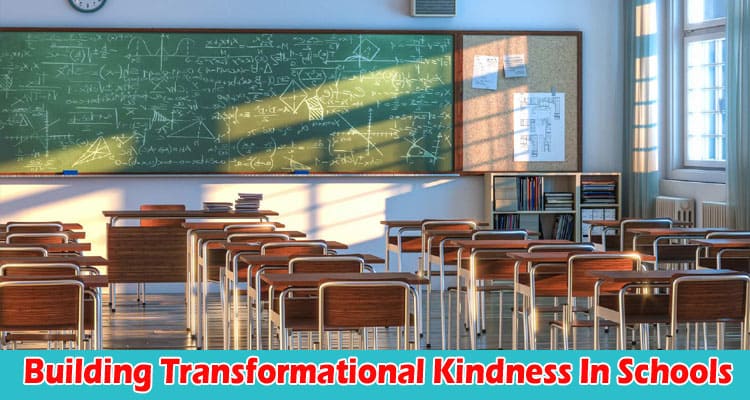Our schools have a kindness problem. With rising rates of bullying, isolation, anxiety and depression among students, it’s clear that many schools struggle to nurture caring relationships and inclusive communities. This takes a toll on learning and development. Research shows that feelings of belonging, emotional safety and care for others provide a foundation for academic growth. As educators, how can we build “transformational kindness” through Building Transformational Classrooms into the core ethos of our schools?
Defining Transformational Kindness
Transformational kindness moves beyond random acts of kindness. It’s about changing systems and mindsets to create a culture rooted in empathy, compassion and care for all. Structures and policies support respectful, caring behaviors. Staff model vulnerability and nurture strong connections among members of the school community. Students feel safe to express their authentic selves. They have opportunities to recognize each other’s shared humanity, to unpack and challenge biases and misunderstandings, and to uplift others’ struggles. Over time, unkind behaviors lose their grip, eclipsed by the contagious warmth of an inclusive culture.
Cultivating Self-Compassion to Combat Judgment
Judgment and criticism often feed unkind behaviors. Self-compassion is the antidote. Educators must nurtureacceptance and care towards ourselves in order to model the same towards students. We can acknowledge our own imperfections and past hurts that may unconsciously impact our behaviors. Through reflection and professional development, we can grow in self-awareness and oversight of our own biases and emotional triggers. As we extend gentleness towards ourselves, judgment loses its grip. We become more able to hold students’ stories with empathy and equip them with the socio-emotional tools they need.
Building Community Through Storytelling
Stories nurture empathy and self-understanding by unveiling our shared struggles and triumphs. Schools can provide regular opportunities for students and staff to voluntarily share stories, listen deeply and find common ground. This may start small, in classroom community circles, and extend into schoolwide storytelling initiatives. Participants reflect on personal experiences related to themes like overcoming adversity, struggling with identity, dealing with loss or finding purpose and sources of strength. As community members share and bear witness to each other’s stories, walls come down. Through story, judgment often transforms into compassion.
Integrating SEL and Academics to Teach Whole Child
Social-emotional competencies don’t compete with academics. They enable academic success and growth of the whole child. Schools committed to transformational kindness fuse SEL into instruction, student support structures and school culture. SEL classroom strategies like cooperative learning, conflict resolution practices, mindfulness and emotional check-ins become normalized. SEL standards detailing relationship-building skills and responsible decision-making complement academic standards. Staff meetings routinely incorporate reflection on building inclusive classrooms. From the classroom to the board room, SEL becomes integral to how we teach, lead and support every student.
Role Modeling Vulnerability and Reconciliation
If students perceive staff as impersonal authority figures, a hierarchy emerges that blocks mutual understanding. Transformational kindness requires educators to step into greater vulnerability and connection with students. Teachers can periodically share stories from their own school struggles and triumphs. Leaders can name institutional harms done to marginalized groups, pledging to continually reconcile and rebuild trust. Modeling humility helps staff stay grounded in service over self-importance. It gives students permission to make mistakes, while being accountable. Ultimately vulnerability dissolves barriers, enabling authentic healing.
Building Peer Support Through Student Leadership
Students often share experiences, pressures and challenges unfamiliar to adults. While guidance from staff is needed, students also need to empower each other. Schools can facilitate supportive connections through student leadership initiatives. Peer mediation programs equip students to resolve conflicts among themselves. Peer counselors are trained to provide empathetic listening and refer friends to additional help. Diversity clubs give students space to unite across differences and mobilize around collective struggles. By elevating student voices, schools nurture youth-led advocacy while redistributing caregiving responsibilities among the school community. Students gain autonomy while still supported by adult scaffolds.
Creating Brave Spaces for Open Dialogue
Suppressed prejudices and misunderstandings thrive unseen. Transformational kindness requires brave spaces where students and staff voice biases, call out problematic behaviors, share difficult experiences and raise awareness. One approach is setting community agreements before dialogues on complex issues like racial justice, LGBTQ inclusion or religious pluralism. Agreements may include speaking your truth without attacking others’ truths, “calling in” not “calling out”, avoiding generalizations and giving the microphone to unheard voices. Educators help students untangle charged issues with honesty, critical thinking and historical contextualization. Examining multiple perspectives exercises collective empathy and moral courage while combating polarization.
Nurturing Well-Being Practices Schoolwide
Stress and emotional exhaustion permeate school communities. To sustain harmonious relationships, self-care can’t be an afterthought. Schools committed to kindness dedicate time and resources towards collective wellness. Staff yoga classes before student arrival set the tone of calm. Mindfulness rooms give overwhelmed students an outlet. Therapy dogs visit classrooms supplying mood-boosting affection. Teachers start lessons with rhythmic breathing or give struggling students sensory objects to fidget with. Administrators implement mental health days protecting against burnout. Weaving wellness into everyday school functioning helps sustain emotional capacity to hear each other, extend grace and nurture care.
Conclusion
Beyond programmatic or crisis-response kindness, transformational cultures treat compassion as an endless practice. Like excellence or integrity, kindness gets woven into everyday functioning, policies and language. As staff collaboratively reflect on struggles certain groups face or how behaviors impact others, consideration becomes instinctual. Teachers’ innate sense of safety and belonging replaces truancy threats. Student recognition accelerates for responsibility and relationship-building, not just academic marks. In classrooms, kindness manifests in the protection of collaborative space, the resonance of brave conversations or the force of standardized practices like restorative circles. Over time, compassion becomes the water saturating the soil — not an occasional nourishment. It becomes the school’s root system.







